Sun Safety 101: Sunscreen and Exposure Tips

Shanthi Appelo
| 4 min read

With the long daylight hours and easy access to lakes, rivers and beaches, summer is a great time to be outside in Michigan. But it’s also the time when people’s skin and eyes are most vulnerable to the sun’s rays. This can make prolonged sun exposure dangerous.
However, with a few safety precautions and a little planning, people can confidently enjoy their time outdoors.
Sun protection is important because skin cancer is the most common among all types of cancer. People who are overexposed to the sun’s harmful rays and experience repeated skin damage are at a greater risk for developing skin cancer.
Try these tips on everything from what kind of sunscreen to use, to healthy summer activity ideas.
Different types of sunscreens
There are two main categories of sunscreens:
- Chemical sunscreens: These are the most common. They contain a mix of several ingredients and are popular because they absorb into the skin’s top layer, becoming invisible after application. They reduce the ability of UV radiation to penetrate the skin. These blend into the skin easily, but also need to be absorbed before they become effective, so there is a little lag time between application and protection.
- Mineral sunscreens: These are the sunscreens that sit on top of the skin and can physically be seen as a barrier. Ingredients include zinc oxide and titanium dioxide. They physically block UVA and UVB rays from penetrating the skin. Mineral sunscreens are good for people who have sensitive skin and for babies. They provide immediate protection and tend to have a longer shelf life than chemical sunscreens.
Understanding SPF and “broad spectrum”
Knowing the sun protection factor (SPF) of a sunscreen is important when trying to prevent skin damage. While no sunscreen will block all the sun’s rays, this information can help people decide which SPF products are right for them. According to the Skin Cancer Foundation:
- SPF 15 filters out approximately 93% of all incoming UVB rays
- SPF 30 keeps out 97% of all incoming UVB rays
- SPF 50 keeps out 98% of all incoming UVB rays
Dermatologists recommend using an SPF 30 or higher for people who are outside a lot.
“Broad spectrum” means a sunscreen is designed to protect against both UVB and UVA rays. It’s important because both UVA and UVB ray damage can lead to skin cancer, eye damage and premature aging. If a sunscreen does not have this Food and Drug Administration-approved label, it means it protects only against UVB rays.
When to put on sunscreen
Timing is important for the best protection. People should apply sunscreen 15 minutes before going outdoors. Sunscreen should also be reapplied often. Other sun-safe tips:
- Babies younger than six months old should not be exposed to the sun for prolonged periods of time.
- Everyone should use sunscreen. People with fair skin are more at risk for sunburn and may need more protection.
- Use at least an SPF 30 on children.
- Use water-resistant or waterproof sunscreen if working up a sweat outdoors or swimming.
Ways to protect skin without sunscreen
The best way to protect skin from the sun’s harmful rays does not come in a bottle or tube but rather in the form of preventative behavior. Here’s a to-do list:
- Avoid being in the sun during the day’s most intense time for rays from 10 a.m. to 2 p.m.
- Stay in the shade when possible
- Wear a broad-brimmed hat
- Wear lightweight, long-sleeve shirts and pants
- Wear sunglasses that offer good protection
Safe sun exposure
Being exposed to the sun without wearing sunscreen or protective clothing is only safe for most people for about 20 minutes a day. When temperatures soar, it’s also a warning to stay indoors or in the shade. People who are especially vulnerable to extreme heat include the elderly, children and people with respiratory issues.
Shanthi Appelö is a registered dietitian and health and wellness spokesperson at Blue Cross Blue Shield of Michigan. For more health tips and information, visit AHealthierMichigan.org.
Photo credit: Getty Images
Keep reading:





